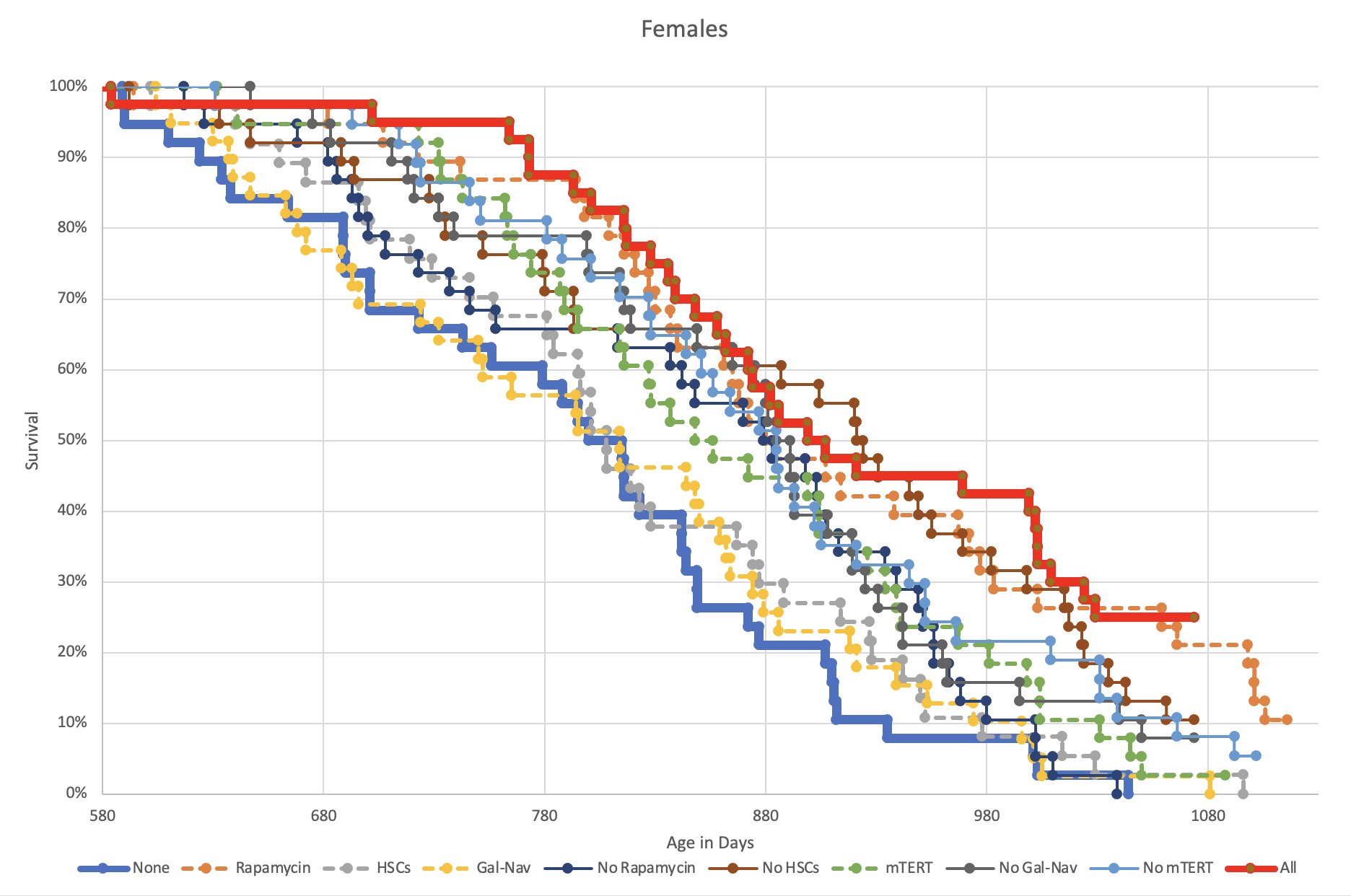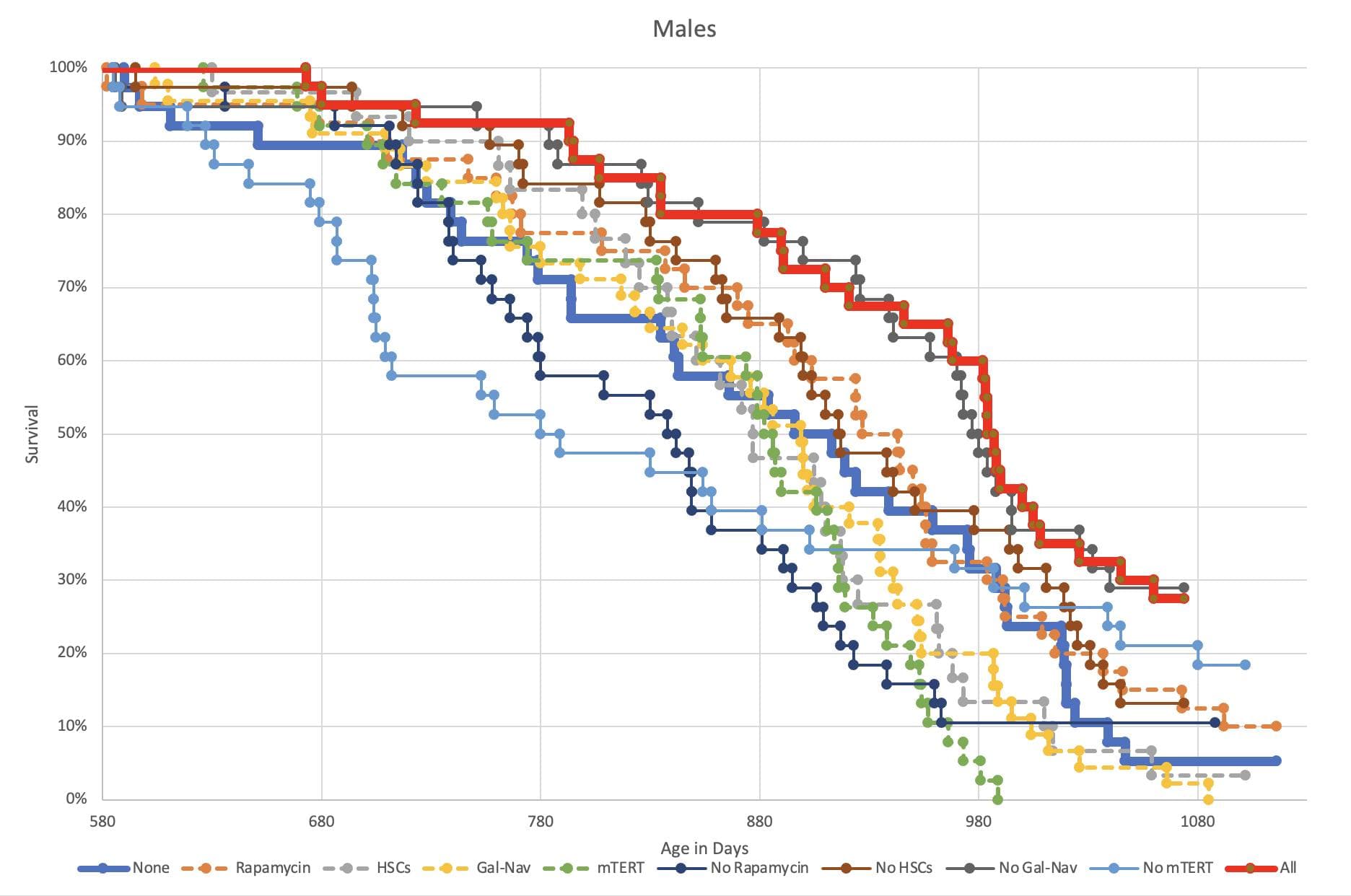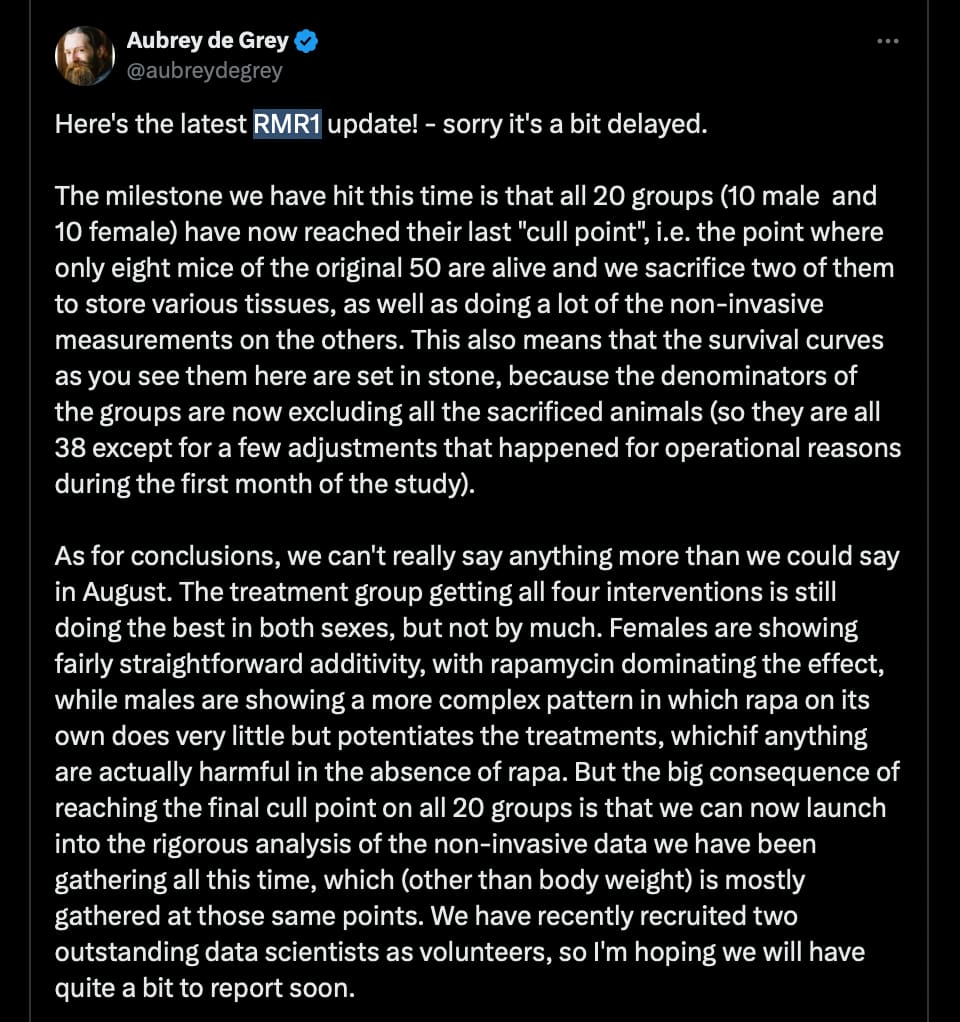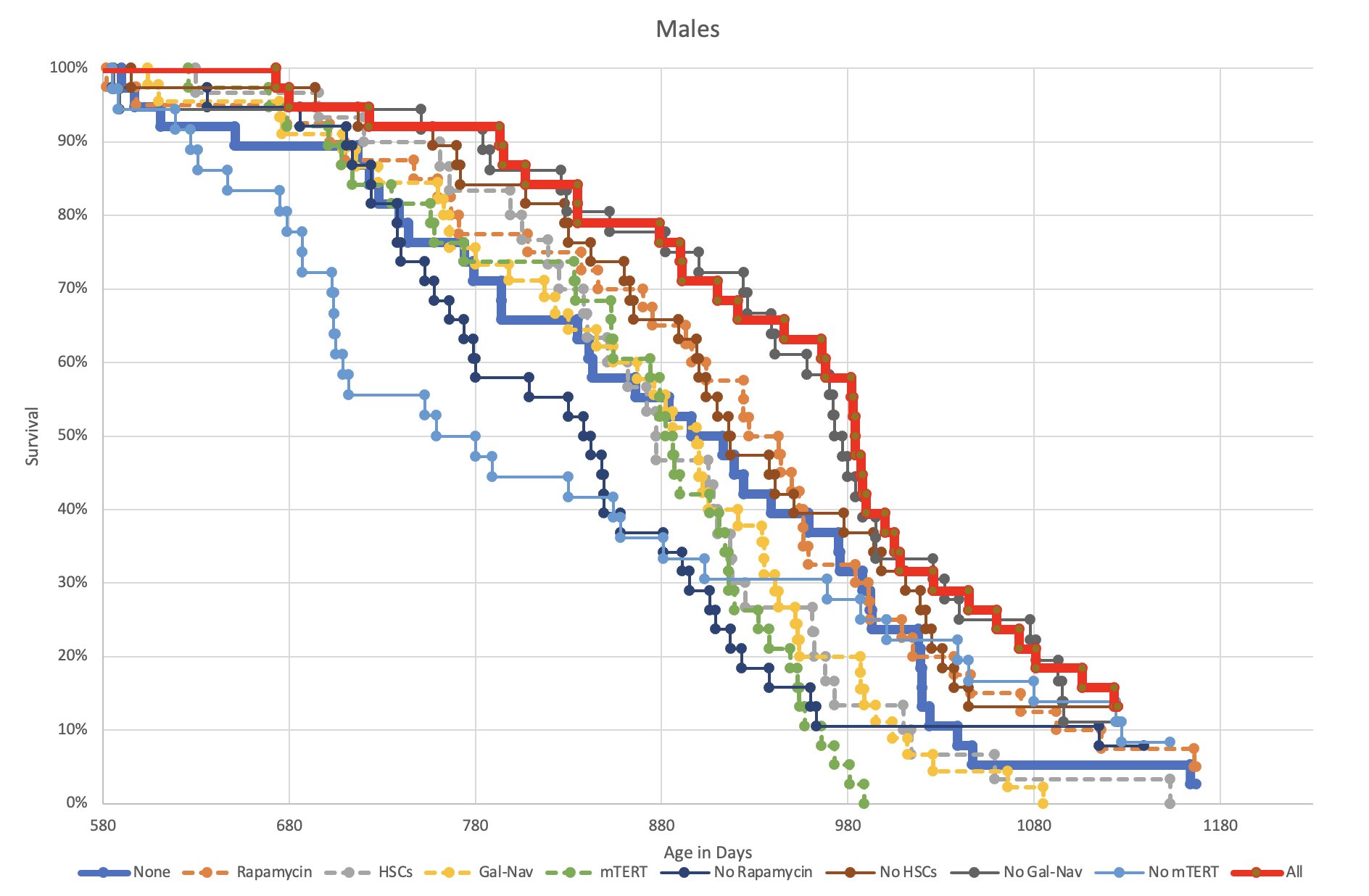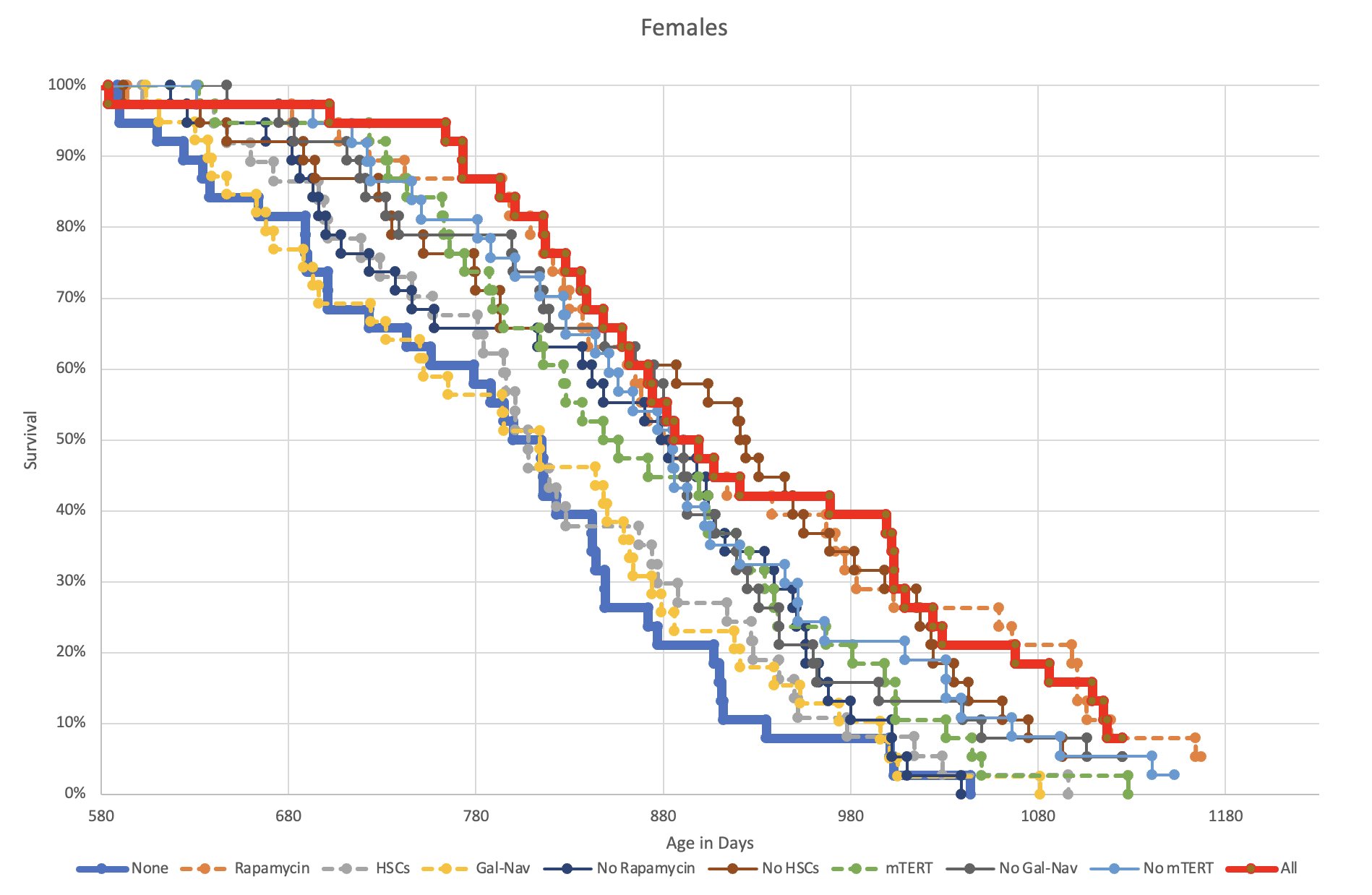Cancer is becoming an issue for younger people. I think that is because a lot of cancer is metabolically driven rather than genetically.
I find this a bit alarming. If the only treatment that’s working in female mice is Rapa then it really doesn’t bode well. Shouldn’t we expect at least some of them to work in females?
From Aubrey, here: x.com
Here’s the August RMR1 update!
We’re getting fairly near to the end of the study - but how near, we certainly can’t yet say. Six of the 20 treatment groups, two male and four female, are now extinct, but the all-treatment groups of both sexes are still at 25% survival at over 35 months of age, which gives hope that the longest-lived mouse in the entire study will turn out to be fairly impressive. Across all 20 groups combined, 67 mice are still alive.
The more detailed analysis, teasing out the relative impact of different treatments, is getting more and more clear and interesting. Here are a few highlights.
I think we have to accept that our senolytic was a bust. We have some theories about why - more on that in due course - but in short we definitely do NOT think senolytics in general are useless, just that there’s still some way to go to extract their full potential.
As I noted in the last update, the impact of the other damage-repair treatments (HSCs and telomerase) over and above rapamycin is disappointingly insignificant in females but looks rather good in males. In fact, at this point it begins to be arguable that the damage-repair treatments actually DIMINISH the benefits of rapa in females - but have the opposite, i.e. beneficial, impact in males. This is definitely something requiring more thought - and, of course, more studies - but first let’s see how things look when RMR1 is complete.
The only-telomerase group is the one with the starkest sex-disparity: bucking the above trend, it was downright bad for male mice but definitely beneficial for females. Was that disparity big enough to survive statistical significance, given how many hypotheses we are testing simultaneously in this study? Watch this space!
In that vein, I must as usual repeat my caution not to run too much with any of this quite yet. Nothing that I say above has been validated by rigorous statistical analysis, and the main reason it hasn’t is that there is still so much that can change as a result of those last 67 mice. If you doubt me, just look at the all-but-rapa males over the past 250 days. In the first 125 of those days, there were 15 deaths, reducing the cohort from 19 to 4 (not including those culled for tissues); and in the subsequent 125 days, there have been… zero deaths. We can expect more such fluctuations - it’s an inevitable consequence of the fact that this experiment started with “only” 1000 mice, not 10000.
It’s becoming clear that the senolytic approach has utterly failed.
The marginal benefit of moving to additional therapeutics over rapamycin seems pretty minimal in this case.
The marginal benefit of moving to additional therapeutics over rapamycin seems pretty minimal in this case.
This is especially the case for female mice. But for male mice the effect of combinational therapies are much higher. I will post an update on that on that later this week.
Props to de Grey for the aggressive testing project. Especially since the results look terrible for the whole SENS/damage theory worldview. Of all the things tested it seems plausible that the only one that works is also the only one not targeted at some hypothetical form of damage, i.e. the only one that is not in accordance with the SENS program.
To be fair to Aubrey de Grey he has suggested that inefficient mitochondria (which result from damage to the mitochondrial DNA) lie behind aging for some time. Rapamycin fixes the damaged mitochondria (by getting the body to recycle them).
BTW which mice are they using?
This is interesting but it looks like it fails Matt’s 900 days rule.
If the theory of rapamycin getting the body to recycle mitochondrial DNA as the primary driver of longevity benefit, shouldn’t be a more frequent but lower dose rapamycin regimen be better, such as twice a week for 3mg each vs 6mg weekly? The German mice study has testified that a more chronic dosing is better for healthspan.
As I see it the issue is within any one cell setting the threshold in terms of mitochondrial membrane potential at a higher point. Hence a higher level of mTOR inhibition if for a shorter period would achieve the objective.
Also I think having mTOR behaving normally most of the time is best.
If you have a link to the German study that would be good.
I think with longer lived creatures there are different priorities as well.
What geman mice study are you thinking about?
According to the website “pre-aged C57/B6 mice”. Seems like the mice started dying just a month after they were bought (18 months).
Rapamycin
Males 780 → 940 days
Females 800 → 880 days
The extension in female mice seems significantly less than expected.
Anyone see another Rapa study using such short lived controls?
Here is the link of German mice study, stating chronic dosing is better for healthspan. I personally testing 2x a week regiment vs weekly and I felt subjectively that I am doing better energy wise.
Intermittent rapamycin feeding recapitulates some effects of continuous treatment while maintaining lifespan extension - #5 by Jonas @Krister_Kauppi
Do you have a link to the original study so we can examine the details?
Thanks for that link which gave a link to the actual study
From 6 months of age, male and female C3B6F1 hybrid mice were either continuously fed with 42 mg/kg rapamycin, or intermittently fed by alternating weekly feeding of 42 mg/kg rapamycin food with weekly control feeding.
To me that is two versions of chronic treatment.
Ah, but mice process rapamycin very quickly, typically 4 times faster than humans. So not exactly chronic by mouse standards: 17-alpha-Estradiol Study in Marmosets - #3 by RapAdmin
